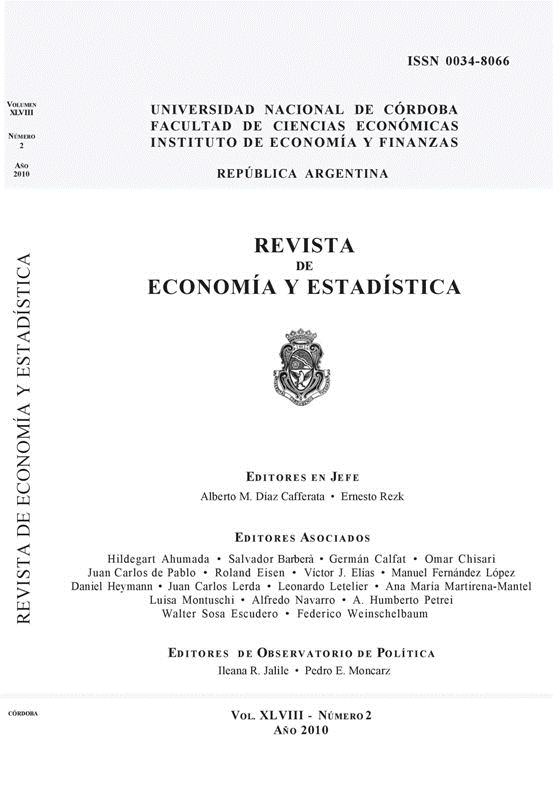The Reaction of Fiscal Policy to the Crisis in Italy and Germany: Are they really polar Cases in the European Context?
DOI:
https://doi.org/10.55444/2451.7321.2010.v48.n2.4108Keywords:
discretionary fiscal policy , automatic stabilizers , Germany, ItalyAbstract
The deep recession which hit the world economy towards the end of 2008 inducedmassive, internationally-coordinated policy responses, both monetaryand fi scal. In this paper we examine public fi nance developments in Germanyand Italy in 2009. We fi nd that the larger stimulus measures adopted inGermany mostly compensated a more favourable underlying trend; overall,the cyclically-adjusted primary balances worsened by a similar extent in thetwo countries. We further estimate the automatic stabilisers to have had animpact on the defi cit of similar magnitude in Germany and Italy. We thenassess, on the basis of counterfactual simulations, to which extent discretionarymeasures and automatic stabilizers were able to mitigate the downturnin the two countries. Our results show that the public sector contrastedthe fall in real GDP in 2009 by more than 2 percentage points in Germany andby 1 per cent in Italy. The difference in the stabilizing effect of the two public sectors refl ects not only the different size of the stimulus measures, but also thehigher fi scal multipliers associated with Germany.
Downloads
References
Alesina, A. and S. Ardagna (1998), “Tales of Fiscal Adjustment”, Economic Policy, Vol. 13, No. 27, pp. 487-545.
Alesina, A. and R. Perotti (1995), “Fiscal Expansions and Fiscal Adjustments in OECD Countries”, NBER, Working Paper, No. 5214.
Alesina, A. and R. Perotti (1996), “Fiscal Adjustment in the OECD Countries: Composition and Macroeconomic Effects”, NBER, Working Paper, No. 5730.
Altissimo, F., S. Siviero and D. Terlizzese (2002), “How Deep are the Deep Parameters?”, Annales d’Economie et de Statistique, No. 67/68, pp. 207-26.
Balassone, F., D. Franco, S. Momigliano and D. Monacelli (2002), “Italy: Fiscal Consolidation and Its Legacy”, in Banca d’Italia, The Impact of Fiscal Policy, papers presented at the Workshop organized by the Banca d’Italia in Perugia, 21-23 March.
Banca d’Italia (1999), Indicators of Structural Budget Balances, papers presented at the Workshop organized by the Banca d’Italia in Perugia, 26-28 November.
Bouthevillain, C., P. Cour-Thimann, G. Van den Dool, P.H. De Cos, G. Langenus, M. Mohr, S. Momigliano and M. Tujula (2001), “Cyclically-adjusted Budget Balance: An Alternative Approach”, ECB, Working Paper, No. 77.
Braz, C.R. (2006), “The Calculation of Cyclically-adjusted Balances at Banco de Portugal: An Update”, Economic Bulletin, Vol. 12, No. 4, Banco de Portugal.
Busetti, F., A. Locarno and L. Monteforte (2005), “The Bank of Italy’s Quarterly Model”, in Fagan and Morgan (2005).
Caivano, M., L. Rodano and S. Siviero (2010), “La trasmissione della crisi all’economia italiana. Un’indagine controfattuale, 2007-2010”, Banca d’Italia, mimeo.
Church, K.B., J.E. Sault, S. Sgherri and K.F. Wallis (2000), “Comparative Properties of Models of the UK Economy”, National Institute Economic Review, No. 171, January.
Corriere della Sera (1998), “Italia nella moneta unica con sei impegni”, 22 March.
Dalsgaard, T., C. André and P. Richardson (2001), “Standard Shocks in the OECD Interlink Model”, OECD, Economic Department, Working Paper, No. 306, OECD Publishing.
De Castro, F., J. Kremer and T. Warmedinger (2010), “How to Measure a Fiscal Stimulus?”, Presupuesto y Gasto Público, No. 59, pp. 103-16.
Degni, M., N. Emiliani, F. Gastaldi, G. Salvemini and C. Virno (2001), “Il riequilibrio della finanza pubblica negli anni Novanta”, Studi e Note di Economia, Quaderni, No. 7.
European Commission (2009), “Public Finances in EMU 2009”, European Economy, No. 5/2009.
Fagan, G. and J. Morgan (eds.) (2005), Econometric Models of the Euro-area Central Banks, Edward Elgar, Cheltenham (UK).
Farmer, R.E. (1991), “The Lucas Critique, Policy Invariance and Multiple Equilibria”, Review of Economic Studies, pp. 321-32.
Favero, C.A. and D.F. Hendry (1992), “Testing the Lucas Critique: A Review”, Econometric Reviews, Vol. 11, No. 3, pp. 265-306.
Forni, L. and S. Momigliano (2004), “Cyclical Sensitivity of Fiscal Policies Based on Real-time Data”, Applied Economics Quarterly, Vol. 50, No. 3, pp. 299-326.
Franco, D. (2002), “Italy: A Never-ending Pension Reform”, in M. Feldstein and H. Siebert (eds.), Coping with the Pension Crisis – Where Does Europe Stand?, Chicago, Chicago University Press.
Franco, D. and P. Rizza (2008), “Ensuring a Sustainable Fiscal Consolidation”, in Italy in EMU: The Challenges of Adjustment and Growth, Palgrave, forthcoming.
Hamburg, B. and K.H. Tödter (2005): “The Macroeconometric Multi-country Model of the Deutsche Bundesbank”, in Fagan and Morgan (2005), pp. 119-36.
Hendry, D.F. (1988), “Testing Feedback vs. Feedforward Econometric Formulations”, Oxford Economic Papers, pp. 132-49.
Henry, J., P. Hernández de Cos and S. Momigliano (2008), “The Short-term Impact of Government Budgets on Prices: Evidence from Macroeconometric Models”, Journal of Policy Modeling, Vol. 30, No. 1, pp. 123-43.
IMF (2009), World Economic Outlook – Prospects and Policies.
Kremer, J., C.R. Braz, T. Brosens, G. Langenus, S. Momigliano and M. Spolander (2006a), “A Disaggregated Framework for the Analysis of Structural Developments in Public Finances”, ECB, Working Paper, No. 579.
Kremer, J., C.R. Braz, T. Brosens, G. Langenus, S. Momigliano and M. Spolander (2006b), “A Disaggregated Framework for the Analysis of Structural Developments in Public Finances”, in Banca d’Italia (2007), Fiscal Indicators, papers presented to the Workshop organized by the Banca d’Italia in Perugia on 30 March-1 April.
Kremer, J. and K. Wendorff (2004), “Germany After the Qualification for EMU: A Disaggregated Approach to the Analysis of Structural Public Finance Developments”, in Vierteljahreshefte zur Wirtschaftsforschung, Vol. 73, No. 3, pp. 358-70.
Lucas, R.E. (1976), “Econometric Policy Evaluation: A Critique”, in K. Brunner and A. Meltzer (eds.), The Phillips Curve and Labor Market, Amsterdam, North-Holland.
Marino, M.R., S. Momigliano and P. Rizza (2008a), “A Structural Analysis of Italy’s Fiscal Policies After Joining the European Monetary Union: Are We Learning From Our Past?”, Public Finance and Management, Vol. 8, No. 3, pp. 451-501.
Marino, M.R., S. Momigliano and P. Rizza (2008b), “I conti pubblici nel decennio 1998-2007: fattori temporanei, tendenze di medio periodo, misure discrezionali”, Banca d’Italia, Occasional Papers, No. 15.
Mc Dermott, C. and R. Westcott (1996), “An Empirical Analysis of Fiscal Adjustments”, IMF, Staff Paper, Vol. 43, No. 4, pp. 725-53.
Momigliano, S. and P. Rizza (2007), “Temporary Measures in Italy: Buying or Losing Time?”, in Temporary Measures and Off-budget Activities, Magyar Nemzeti Bank.
Momigliano, S. and S. Siviero (1997), “The Public Budget and Economic Activity in the 1990’s: An Analysis with the Bank of Italy Quarterly Econometric Model”, Politica Economica, No. 4.
Momigliano, S. and A. Staderini (1999), “A New Method of Assessing the Structural Budget Balance: Results for the Years 1995-2000”, in Banca d’Italia, Indicators of Structural Budget Balances, papers presented to the Workshop organized by the Banca d’Italia in Perugia on 26-28 November 1998, Rome, pp. 119-58.
Prammer, D. (2004), “Expansionary Fiscal Consolidations? An Appraisal of the Literature on Non Keynesian Effects of Fiscal Policy and a Case Study for Austria”, Monetary Policy and the Economy, No. 3, pp. 35-52.
Reinhart C.M. and K.S. Rogoff (2009), “Growth in a Time of Debt”, mimeo, prepared for the American Economic Review Papers and Proceedings.
Sims, C. (1982), “Policy Analysis with Econometric Models”, Brookings Papers on Economic Activity, pp. 106-52.
Downloads
Published
How to Cite
Issue
Section
License
Copyright (c) 2010 Britta Hamburg, Sandro Momigliano, Bernhard Manzke, Stefano Siviero

This work is licensed under a Creative Commons Attribution-NonCommercial-NoDerivatives 4.0 International License.
Authors who have publications with this journal agree to the following terms:
Authors retain their copyright and grant the journal the right of first publication of their work, which is simultaneously subject to the Creative Commons Attribution-NonCommercial-NoDerivatives 4.0 International License that allows third parties to share the work provided that its author and first publication in this journal are indicated.
Authors may adopt other non-exclusive licensing arrangements for distribution of the published version of the work (e.g. depositing it in an institutional telematic archive or publishing it in a monographic volume) as long as the initial publication in this journal is indicated.
Authors are allowed and encouraged to disseminate their work via the Internet (e.g. in institutional telematic archives or on their website) before and during the submission process, which can lead to interesting exchanges and increase citations of the published work. (See The Open Access Effect)









